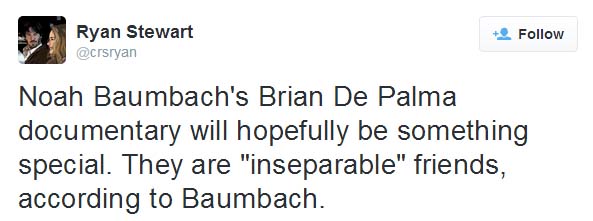
Updated: Sunday, August 2, 2015 10:37 PM CDT
Post Comment | Permalink | Share This Post
 Hello and welcome to the unofficial Brian De Palma website. Here is the latest news: |
|---|
E-mail
Geoffsongs@aol.com
-------------
Recent Headlines
a la Mod:
Listen to
Donaggio's full score
for Domino online
De Palma/Lehman
rapport at work
in Snakes
De Palma/Lehman
next novel is Terry
De Palma developing
Catch And Kill,
"a horror movie
based on real things
that have happened
in the news"
Supercut video
of De Palma's films
edited by Carl Rodrigue
Washington Post
review of Keesey book
-------------
Exclusive Passion
Interviews:
Brian De Palma
Karoline Herfurth
Leila Rozario
------------
------------
| « | August 2015 | » | ||||
| S | M | T | W | T | F | S |
| 1 | ||||||
| 2 | 3 | 4 | 5 | 6 | 7 | 8 |
| 9 | 10 | 11 | 12 | 13 | 14 | 15 |
| 16 | 17 | 18 | 19 | 20 | 21 | 22 |
| 23 | 24 | 25 | 26 | 27 | 28 | 29 |
| 30 | 31 | |||||
De Palma interviewed
in Paris 2002
De Palma discusses
The Black Dahlia 2006

Enthusiasms...
Alfred Hitchcock
The Master Of Suspense
Sergio Leone
and the Infield
Fly Rule
The Filmmaker Who
Came In From The Cold
Jim Emerson on
Greetings & Hi, Mom!
Scarface: Make Way
For The Bad Guy
Deborah Shelton
Official Web Site
Welcome to the
Offices of Death Records

IMPOSSIBLE MISSION FORCE from Sean Witzke on Vimeo.
Thanks to Rado for sending along the link to the above video, which spends a hefty amount of its running time on Brian De Palma's initial film in the Mission: Impossible franchise. Made by Sean Witzke, the video mentions a couple of films in regard to De Palma's film that I hadn't considered prior: Ronald Neame's Gambit and Roman Polanski's Macbeth. Here's my transcript of Witzke's narration during the De Palma portion (parts of Witzke's narration gets inaudible or buried, so there's a piece or two I was unsure of)...
Cruise and Wagner selected Brian De Palma to adapt the ‘60s TV series into a film. I’ve always felt that Mission: Impossible is the closest film in De Palma’s catalog to Carrie: an established property, and in the mainstream, but one that applies directly to his abilities, his style, and his obsessions. It’s a film he knew how to make. The property has all the hallmarks of a De Palma film: suspense, narrative and visual formal playfulness, betrayal, impotence, conspiracies on conspiracies, a hero with a self-destructive fixation, and brutal audience manipulation.It is the most film-literate of the franchise. De Palma’s love of Hitchcock is long documented, and at this point, completely internalized. Instead, he nods towards films we call Hitchcockian. De Palma and his longtime editor Paul Hirsch dance with the material, intercutting guy-in-the-van heist staples with arresting sequences where you’re held in tension forever. De Palma would indulge the explosive green-screen spectacle that is the expectation of the genre, but he would spend an equal amount of time on silence, menace. De Palma’s homage to blacklisted American director Jules Dassin’s Euro-caper film Topkapi, about a team of amateur thieves stealing royal Turkish emeralds, also involves an acrobatic feat and a pressure-sensitive floor. But perhaps an unspoken influence is Ronald Neame’s Gambit, a ‘60s film that also has an acrobatic heist sequence. Gambit’s narrative trick, where we see Michael Caine’s perfect idea of a planned heist play out as fantasy before we see it play out for real, his clockwork ideas presented in a way that at first hides his incompetence and ability to adapt in crisis, unlike the amateur he hires as a distraction, who is a natural thief.
In the first film, characters are constantly telling stories, to one another, to themselves. IMF operatives are taught to narrativize their lies, and Ethan Hunt’s most useful skill is to quickly formulate or see through lies. The film’s biggest set pieces are a television episode link building and destroying what the audience expects from the film, dropping the bodies of a whole team of the type of actors who get cast in a big-screen reboots of properties, including a career-best uncredited turn from Emilio Estevez. The cast is then replaced with actors best known for working with Luc Besson, Claude Chabrol, Quentin Tarantino. A rejection of Hollywood slickness in favor of the kind of cinema De Palma finds exciting. Similarly, the plan for the Langley heist takes its time to beat up the poor analyst that’s in their way, torturing him like an ant getting its legs ripped off under a microscope.
De Palma’s most interesting homage is to Roman Polanski’s adaptation of Macbeth, filmed immediately after his wife Sharon Tate’s death. Banqua’s ghost appears as a blood-soaked corpse. The editing is what makes it seem unreal, the accusing dead man [isn’t?]. Jon Voight’s Jim Phelps appears to Hunt the same way. De Palma and Cruise present Ethan Hunt as somewhere between a Hamlet and Macbeth, a callow youth smarter than everyone around him, willing to set his whole life on fire to prove a point. Cruise approached De Palma to direct the sequel, but he had moved on, had already made his idea of the action film.
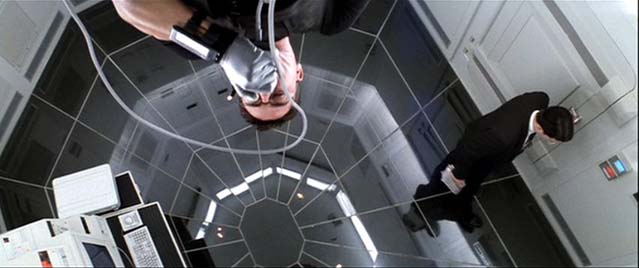
"The first Mission: Impossible movie, a spinoff from the 1960s television show, was released 19 years ago and was, though it’s almost hard to believe it now, something of an auteurist event, having been directed by Brian De Palma. Mr. Cruise was an established action star by 1996, but he also helped produce the first film, which strengthened his status as an international brand. As a star-auteur, he has always been the most important feature and effect of the series, although it’s telling that Mr. De Palma oversaw the set-piece that gave the movies their foundational image: Mr. Cruise’s operative, Ethan Hunt, hovering like a spider (or a puppet) above a luminous white floor while suspended by a very thin rope.
"As the clock tick-tocks, and Ethan struggles to keep his cool — a single drop of sweat splashed on the floor would blow the operation — the visual gloss and high-tech gobbledygook, Mr. Cruise’s graceful athleticism and Mr. De Palma’s New Hollywood suspense chops flow together, turning the scene into the emblematic Mission: Impossible showstopper. It’s the kind of pure cine-spectacle that jolts you before sweeping you up. There’s never been a scene in the series as memorable as that one, even if the exploding fish tank, the film’s other eye-popper, comes close. These sequences set a high bar both for directors who followed in Mr. De Palma’s wake and for Mr. Cruise’s physical performance, which in the later installments has largely involved progressively scarier stunts...
"Clearly Mr. McQuarrie and his star feel the need to stamp the series with seriousness, something that Mr. De Palma knew better than to do. And throughout Rogue Nation, you can sense the filmmakers comfortably, at times awkwardly, playing tug of war with the mood, which grows sinister with the excellent Sean Harris as the regulation evil genius and almost frisky with Alec Baldwin as an intelligence blowhard and Tom Hollander as a political boob. Mr. Pegg’s second-banana flair is especially crucial here because it helps show that Mr. Cruise, whose smile at times seems awfully strained these days, can still take a ribbing as well as a licking."
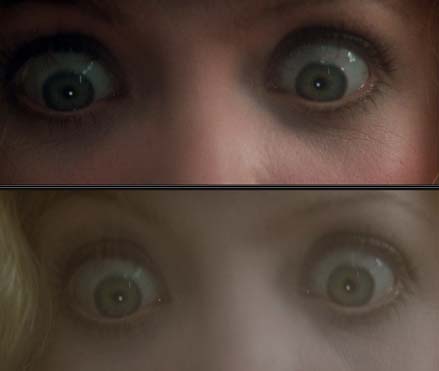 The juxtaposition at left, taken from the DVD Beaver review of Dressed To Kill from the other day, shows the Arrow edition at the top, and the new Criterion edition at the bottom. In this particular shot, it appears that the Criterion edition has the correct aspect ratio, while the Arrow version looks as though it may have been stretched horizontally. However, according to a review by Dr. Svet Atanasov at Blu-ray.com, the Criterion disc they were sent features "numerous serious framing anomalies," including stretching and the top of the frame being lowered "too much." "Needless to say," states Atanasov, "the overwhelming majority of the film looks very awkwardly framed. There are no problematic degraining or sharpening adjustments. Colors are stable and healthy, never appearing artificially boosted. There are no large debris, cuts, damage marks, or torn frames, but I noticed a few tiny flecks. Finally, overall image stability is outstanding."
The juxtaposition at left, taken from the DVD Beaver review of Dressed To Kill from the other day, shows the Arrow edition at the top, and the new Criterion edition at the bottom. In this particular shot, it appears that the Criterion edition has the correct aspect ratio, while the Arrow version looks as though it may have been stretched horizontally. However, according to a review by Dr. Svet Atanasov at Blu-ray.com, the Criterion disc they were sent features "numerous serious framing anomalies," including stretching and the top of the frame being lowered "too much." "Needless to say," states Atanasov, "the overwhelming majority of the film looks very awkwardly framed. There are no problematic degraining or sharpening adjustments. Colors are stable and healthy, never appearing artificially boosted. There are no large debris, cuts, damage marks, or torn frames, but I noticed a few tiny flecks. Finally, overall image stability is outstanding."1. There are some very strange anomalies on the upcoming release of Dressed to Kill, but at the moment I don't know if Mr. De Palma is aware of them.2. The anomalies appear throughout the entire film, and some are very distracting. The credits confirm that at least three different parties were involved with the restoration, so I am unsure how they could have been missed. However, there are also areas of the film that look fine.
3. Color scheme -- I saw that there are some claims that the film is "tealed", etc. This isn't true. Criterion's Lee Kline is responsible for the color grading and he is someone that understands extremely well what he is doing.
4. Lastly, I don't know if there is some sort of mastering/encoding defect -- something that caused the stretching externally. However, I don't like to speculate, so when/if there is some new factual information I will update the review/community.
And then last night, pro-bassoonist posted the following on the forum:
Hey guys,Criterion are aware of the issue. As usual, when there is enough helpful information, there will be a response.
The information will be made available here.
In the meantime, could we please drop the overreactions and move on? Thanks.
Pro-B
Atanasov's review includes the following text from the leaflet provided with the Criterion release:
"The version of the film included here is director Brian De Palma's original and preferred unrated cut. Supervised by De Palma, this new digital transfer was created in 4K resolution on a Scanity film scanner from the 35mm original camera negative; a 35mm interpositive was also used for additional footage for this cut. Benjamin Sutor at Sony Colorworks in Culver City, California, supervised the conform of unrated content to the original R-rated theatrical version to correctly assemble this master. Thousands of instances of dirt, debris, scratches, splices, and warps were manually removed using MTI's DRS, while Digital Vision's Phoenix was used for small dirt, grain, noise management, jitter, and flicker.The original monaural soundtrack was remastered at 24-bit from the 35mm magnetic tracks. Clicks, thumps, hiss, hum, and crackle were manually removed using Pro Tools HD, AudioCube's integrated workstation, and iZotope RX 4.
Transfer supervisor: Brian De Palma. Colorist: Lee Kline/Criterion, New York."
Atanasov's review also provides details about the special features included in Criterion's edition. Here are Atanasov's reviews of the new extras produced for this release:
Interviews -
1. Brian De Palma - in this brand new video interview, director Brian De Palma discusses with filmmaker Noah Baumbach the evolution of his style, Dressed to Kill and the structure of its narrative, the use of specific sounds in different sequences, Pino Donaggio's score and how the anxiety and paranoia in the film are linked to it, Michael Caine's performance, the film's controversial reception, Alfred Hitchock's influence on his work, etc. The interview was conducted exclusively for Criterion in 2015. In English, not subtitled. (20 min, 1080p).
2. Nancy Allen - in this brand new video interview, Nancy Allen explains how she was approached to play the character of Liz Blake and how she prepared for the role, and discusses her interactions with costume designer Ann Roth, her work with Keith Gordon and Michael Caine (with some great comments about the seduction sequence), etc. The interview was conducted exclusively for Criterion in 2015. In English, not subtitled. (17 min, 1080p).
3. George Litto - in this new video interview, producer George Litto discusses his collaborations with Brian De Palma on Obsession, Dressed to Kill, and Blow Out. The interview was conducted exclusively for Criterion in 2015. In English, not subtitled. (17 min, 1080p).
4. Pino Donaggio - in this new video interview, composer Pino Donaggio discusses the score he created for Dressed to Kill as well as his long professional relationship with Brian De Palma. The two began working together in 1976, after Brian De Palma heard the score for Don't Look Now, and their first project was the horror thriller Carrie. The interview was conducted exclusively for Criterion in 2015. In Italian, with optional English subtitles. (16 min, 1080p).
5. Victoria Lynn Johnson - in this new video interview, former model and 1978 Penthouse Pet of the Year Victoria Lynn Johnson explains how she was approached to do the erotic shower scene in the very beginning of Dressed to Kill. (She was Angie Dickinson's body double). The interview was conducted exclusively for Criterion in 2015. In Italian, with optional English subtitles. (9 min, 1080p).
6. Stephen Sayadian - in this new video interview, Stephen Sayadian, the photographic art director for the original Dressed to Kill one-sheet poster, describes how the original design was created and discusses the importance of poster-driven promotion at the time. The interview was conducted exclusively for Criterion in 2015. In Italian, with optional English subtitles. (11 min, 1080p).
Defying Categories: Ralf Bode - in this new featurette, filmmaker Michael Apted (Gorky Park, Blink) and experimental video artist Peer Bode (We Can't Go Home Again) discuss the legacy and working methods of the late cinematographer Ralf Bode, who lensed Dressed to Kill. The featurette was produced exclusively for Criterion in 2015. In English, not subtitled. (11 min, 1080p).
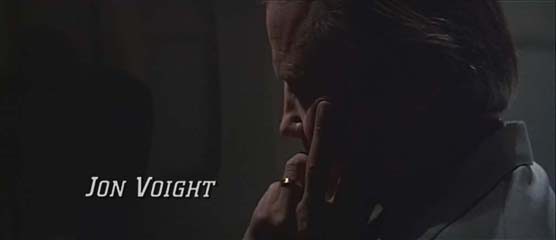
"For not just trafficking in the de-sexualized PG-13 rating (the very first of his career) but also having the pressure of a tie-in N64 game, U2 song on the soundtrack, and likely soda / potato chip / fast food promotion of some sorts, the easy narrative would be to say the subversive artist of Hi, Mom! took a necessary paycheck gig coddling a star’s ego to bide time until his next passion project. Yet one locates in Mission: Impossible not a tension or subservience between director and star, but rather a synchronicity. Rather than subvert Cruise’s movie-star image, De Palma’s typically intense formalism situates him in his natural habitat."De Palma is fully aware that Cruise is too big a star to really disappear into a role. He may don a latex face for portions of the film, but he never disguises his iconic voice. Simply put, Ethan Hunt is Tom Cruise: a perfectly poised image (some may say cipher) pirouetting around other perfect images of architecturally stunning European locales or fortress-like CIA headquarters.
"In Cruise having his own James Bond, the film had to jettison the ensemble-based narrative of the original Mission: Impossible television series, leaving only one carry-over from the original: mentor / team leader Jim Phelps, who’s killed off early, anyway. While the Phelps / Hunt dynamic is only briefly established and not really imbued with heavy psychological or emotional weight, its place in the narrative represents a key De Palma theme: the man who fails to save someone. The difference is that this typically hinges on a romantic or sexual angle: John Travolta holding the bloody body of Nancy Allen at the climactic Fourth of July celebration in Blow-Out; Michael J. Fox haunted by reminders of the young Vietnamese girl he was bullied out of protecting from rape and eventual murder in Casualties of War; or, in Body Double, milquetoast Craig Wasson spiraling into the porno underbelly of Los Angeles to avenge the brutal killing of the beautiful neighbor he peeped on.
"Hunt witnesses Phelps’ death on his watch-screen (a spy gadget reconfigured into a De Palma-esque tool of surveillance) and is then later paid a visit in an expressionistic dream sequence — one made bizarre by its canted angles, but even moreso through the exaggerated acting of Jon Voight as a ghost. Yet both instances point to a kind of unreliability affirmed by the later reveal of Phelps as a mole. The presence of a fake image ready to be reconfigured makes it most comparable to Body Double, another film that sees itself changing locations, introducing new characters, and shunning a typical dramatic coherence for the modern cinema of attractions. Who can forget the narrative grinding to a halt for a Frankie Goes to Hollywood music video?
"The difference being that whereas Body Double is a film about Hollywood, Mission: Impossible simply is Hollywood. Although they both take place within a liquid-like world and adhere to a dream logic, the megastar can easily navigate it while the not-quite-in-on-the-joke Craig Wasson gets hopelessly lost. While De Palma still manages to undercut Body Double’s snark with a somewhat melancholic tone, Mission: Impossible is free of anything resembling excess drama. The film may set itself up as something of a revenge picture — Hunt wants to clear his name, and both he and Phelps’ wife also have the intention of getting even with those responsible for the death — but he also remains the life of the party throughout (and in many instances at the expense of the hapless Jean Reno). It’s refreshing, especially compared to how J.J. Abrams’ mostly decent third installment stumbled in the literalness of its romantic subplot, something a melodramatic maximalist like John Woo could at least pull off through sheer force in his sequel.
"The film certainly hasn’t been considered an example of streamlined storytelling, its impenetrable plot becoming the stuff of notoriety. (For one of many examples see a joke made at its expense in a Billy Crystal-digitally-added-into-Jerry Maguire Oscar spoof.) Yet, if to again use De Palma’s film as a cudgel with which to whack contemporary blockbusters, the film feels liberated of the exposition and origin stories that clog up so many franchise affairs. The audience confusion arose from the fact that the film doesn’t hesitate to have every plot line collapse and swallow each other whole. It gives into a pure pop filmmaking desire for where the director wants to stick the camera and how the star will look best in it.
"From the cold open, throwing us in the middle of a mission, we get a sense of the professionals to which this is all old hat (masks are just part of the job, etc.), as well as the film’s most important motion, in that it doesn’t conclude with an action beat (like the Bond openings), but rather the disassembling of a film set. Besides just the 'film about filmmaking' analogy, what Mission: Impossible finds just as (if not more) important than a stunt is the plasticity of a situation and its location."
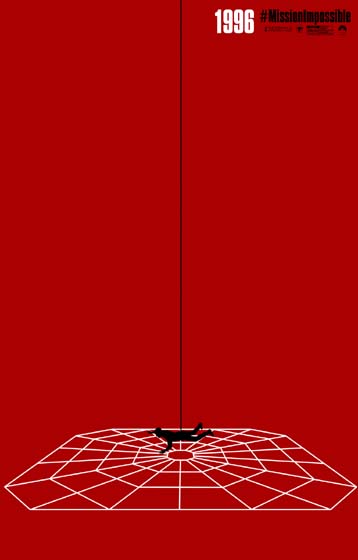 Thanks to Rado for sending along the poster at left, which is part of a series of Saul Bass-style posters put together by Paramount's Rogue Nation promotional team that depict key stunts performed by Tom Cruise throughout the film series. You can see the rest of the posters here.
Thanks to Rado for sending along the poster at left, which is part of a series of Saul Bass-style posters put together by Paramount's Rogue Nation promotional team that depict key stunts performed by Tom Cruise throughout the film series. You can see the rest of the posters here.Matt Perri, The Workprint
"The movie is very stylish. Having Brian De Palma at the helm does that to a film. Seriously, whether you want it or not, you’re getting style. If you were a family member and you handed the camcorder to your cousin, Brian De Palma, the part where you exchange vows with your S.O. would be really intense. But his style works. The claustrophobic camera work and angular shots add a nice dimension to the paranoid mood of the film and Danny Elfman’s score is very much old school, brilliantly mimicking the tackiness of a 60’s spy show with heavy militaristic drums and horns — and the occasional bongo drum to smooth it all out because spies are hip, baby."
Russ Fischer, /Film, The Best ‘Mission: Impossible’ Action Scenes
"Brian De Palma‘s first Mission: Impossible film wasn’t packed with action setpieces — there are only three, really, but those three are all top-tier action filmmaking, and one of those three defined the series for years to come. In the two decades since, the series has been tackled by a variety of directors — John Woo, J.J. Abrams, Brad Bird, and now Christopher McQuarrie — each of whom with a slightly different balance of action and espionage."
Joe Walsh, Cine Vue
"The opening scene with a 53-year-old Cruise clinging to the side of a military plane as it takes off (whilst managing to say his lines) is a sight to behold. McQuarrie and his team have cherry-picked the most enjoyable elements of the previous four instalments and attempted to generate a hybrid Mission: Impossible film. We have a cat and mouse chase through London echoing De Palma's street scenes in Prague and a motorcycle chase through Morocco, near mirroring John Woo's Mission: Impossible II (2000)."
Scott "Movie" Mantz, Access Hollywood
"The fact that Rogue Nation triumphs as an action film with a tightly-plotted screenplay should not come as a surprise, since it was written and directed by Christopher McQuarrie, who won an Oscar for writing 1995's The Usual Suspects and has been on something of a roll with Cruise ever since he co-wrote 2008's under-seen suspense thriller Valkyrie. McQuarrie also co-wrote last year's flat-out brilliant sci-fi epic Edge of Tomorrow, and he wrote and directed 2012's underrated Jack Reacher. (He also did an uncredited script polish on the aforementioned Ghost Protocol.)
"But the key to the success of Rogue Nation is that it moves the Mission: Impossible series forward while also looking back on the staples that made it so great in the first place. The highly publicized stunt with Cruise hanging from the side of an airborne cargo jet is an envelope-pushing nod to his hair-raising climb outside the Burj Khalifa in Ghost Protocol. There's also a gripping underwater break-in scene that brings to mind the dangling heist scene that Brian De Palma directed in the first installment, and that's followed by an exhilarating motorcycle chase that harkens back to what many regard as the best scene from director John Woo's Mission: Impossible II."
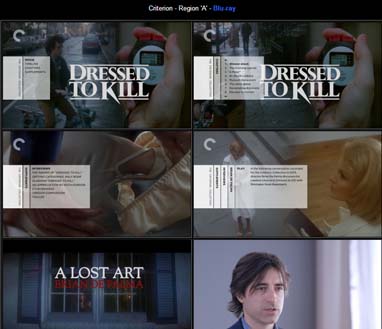 DVD Beaver's Gary Tooze compares three Blu-ray versions of Brian De Palma's Dressed To Kill: MGM, Arrow Films, and the new Criterion. Most striking are the screen shot comparisons reproduced in the post, showing that the new De Palma-supervised Criterion transfer is radically different from the previous two Blu-ray editions. "Wow," states Tooze in the DVD Beaver post. "The Criterion is advertised as a 'New, restored 4K digital transfer of director Brian De Palma’s preferred unrated version, supervised by the director...'. It is extremely different from the other two Blu-rays (both with max'ed out bitrates). It shows more information the frame - mostly on the side edges - and seems vertically stretched (or the other two or horizontally stretched. This makes the criterion faces thinner and taller and the Arrow and MGM faces fatter. It is also more faded and has a yellow/green tinge to it. The Criterion has a less robust technical transfer for the film - with a decent, but lower bitrate. I never saw this theatrically so its hard for me to categorically state this Criterion transfer is not accurate. The Criterion transfer skin tones are cooler. I will say it gave me a new viewing experience. It is also the unrated-cut of the film. NOTE: The round (?) lamp behind Michael Caine (below capture) is oval in the Criterion 1080P, but strangely, at times, the Criterion ratio looks more 'right' to me - at other times the Arrow and MGM appear more natural. The more I look at it though - the more the Criterion appears correct to me."
DVD Beaver's Gary Tooze compares three Blu-ray versions of Brian De Palma's Dressed To Kill: MGM, Arrow Films, and the new Criterion. Most striking are the screen shot comparisons reproduced in the post, showing that the new De Palma-supervised Criterion transfer is radically different from the previous two Blu-ray editions. "Wow," states Tooze in the DVD Beaver post. "The Criterion is advertised as a 'New, restored 4K digital transfer of director Brian De Palma’s preferred unrated version, supervised by the director...'. It is extremely different from the other two Blu-rays (both with max'ed out bitrates). It shows more information the frame - mostly on the side edges - and seems vertically stretched (or the other two or horizontally stretched. This makes the criterion faces thinner and taller and the Arrow and MGM faces fatter. It is also more faded and has a yellow/green tinge to it. The Criterion has a less robust technical transfer for the film - with a decent, but lower bitrate. I never saw this theatrically so its hard for me to categorically state this Criterion transfer is not accurate. The Criterion transfer skin tones are cooler. I will say it gave me a new viewing experience. It is also the unrated-cut of the film. NOTE: The round (?) lamp behind Michael Caine (below capture) is oval in the Criterion 1080P, but strangely, at times, the Criterion ratio looks more 'right' to me - at other times the Arrow and MGM appear more natural. The more I look at it though - the more the Criterion appears correct to me."
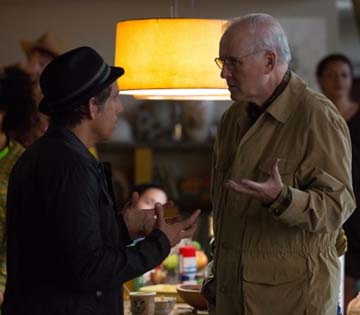 Some surprising news hit this morning as the Venice Film Festival announced its line-up. Among the non-fiction films revealed is a 109-minute documentary called De Palma, co-directed by Noah Baumbach and Jake Paltrow. Variety's Nick Vivarelli notes that the film marks "the first time the somewhat reclusive Brian De Palma talks in-depth about his life and career." Baumbach and Paltrow are friends of De Palma's, of course, and Baumbach has interviewed De Palma on camera twice now for separate Criterion releases: Blow Out, and the upcoming Dressed To Kill. The pair (De Palma and Baumbach) have also appeared on stage together at the New York Film Festival.
Some surprising news hit this morning as the Venice Film Festival announced its line-up. Among the non-fiction films revealed is a 109-minute documentary called De Palma, co-directed by Noah Baumbach and Jake Paltrow. Variety's Nick Vivarelli notes that the film marks "the first time the somewhat reclusive Brian De Palma talks in-depth about his life and career." Baumbach and Paltrow are friends of De Palma's, of course, and Baumbach has interviewed De Palma on camera twice now for separate Criterion releases: Blow Out, and the upcoming Dressed To Kill. The pair (De Palma and Baumbach) have also appeared on stage together at the New York Film Festival.The Venice Film Festival this year runs September 2-12.
Meanwhile, speaking of Baumbach and De Palma, Ari Gunnar noted last month that Charles Grodin, who plays a legendary filmmaker in Baumbach's While We're Young (pictured here), was "cosplaying" in that film as Brian De Palma.